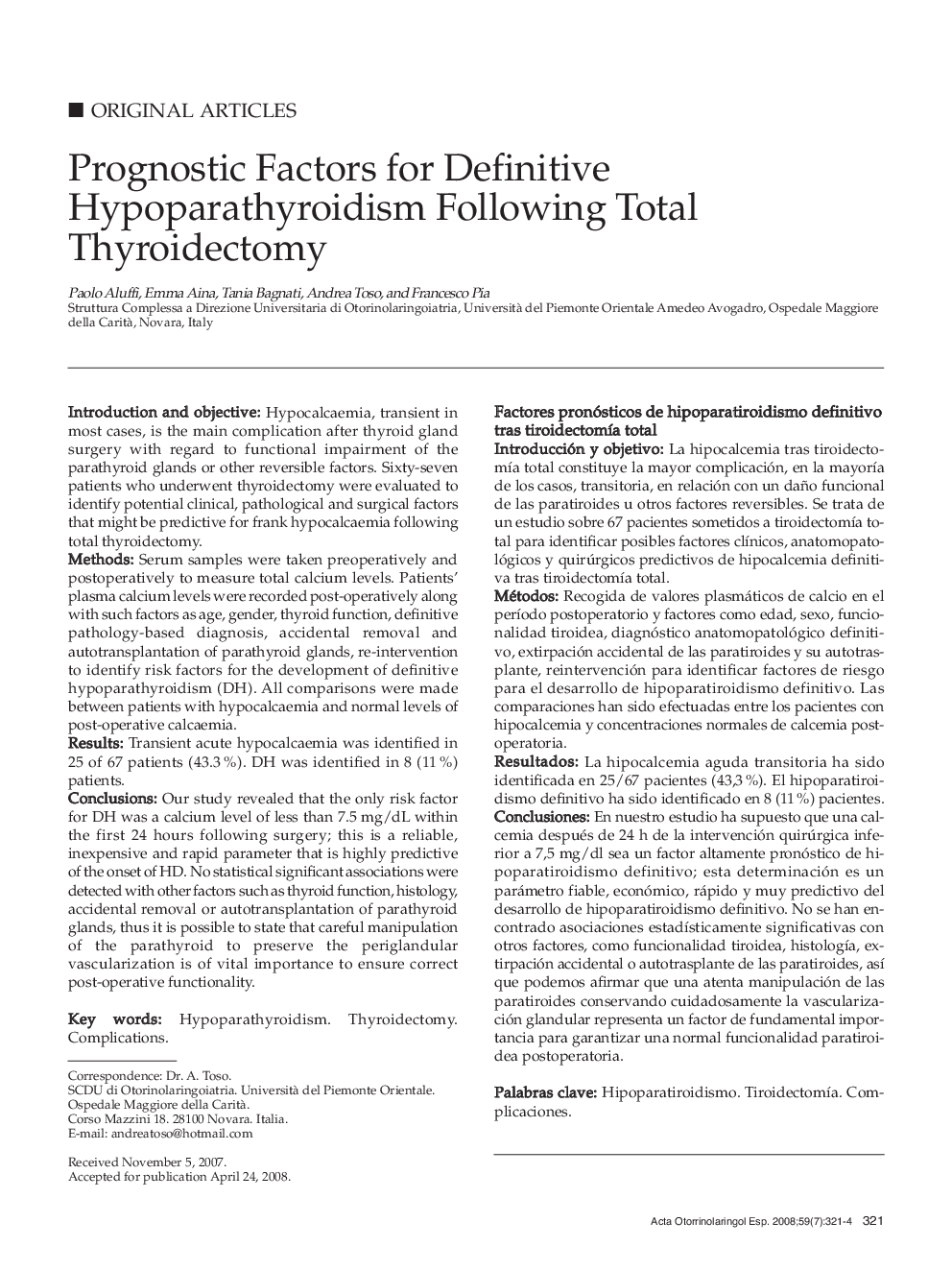| Article ID | Journal | Published Year | Pages | File Type |
|---|---|---|---|---|
| 4101434 | Acta Otorrinolaringologica (English Edition) | 2008 | 4 Pages |
Introduction and objectiveHypocalcaemia, transient in most cases, is the main complication after thyroid gland surgery with regard to functional impairment of the parathyroid glands or other reversible factors. Sixty-seven patients who underwent thyroidectomy were evaluated to identify potential clinical, pathological and surgical factors that might be predictive for frank hypocalcaemia following total thyroidectomy.MethodsSerum samples were taken preoperatively and postoperatively to measure total calcium levels. Patients’ plasma calcium levels were recorded post-operatively along with such factors as age, gender, thyroid function, definitive pathology-based diagnosis, accidental removal and autotransplantation of parathyroid glands, re-intervention to identify risk factors for the development of definitive hypoparathyroidism (DH). All comparisons were made between patients with hypocalcaemia and normal levels of post-operative calcaemia.ResultsTransient acute hypocalcaemia was identified in 25 of 67 patients (43.3%). DH was identified in 8 (11%) patients.ConclusionsOur study revealed that the only risk factor for DH was a calcium level of less than 7.5 mg/dL within the first 24 hours following surgery; this is a reliable, inexpensive and rapid parameter that is highly predictive of the onset of HD. No statistical significant associations were detected with other factors such as thyroid function, histology, accidental removal or autotransplantation of parathyroid glands, thus it is possible to state that careful manipulation of the parathyroid to preserve the periglandular vascularization is of vital importance to ensure correct post-operative functionality.
Introducción y objetivoLa hipocalcemia tras tiroidectomía total constituye la mayor complicación, en la mayoría de los casos, transitoria, en relación con un daño funcional de las paratiroides u otros factores reversibles. Se trata de un estudio sobre 67 pacientes sometidos a tiroidectomía total para identificar posibles factores clínicos, anatomopatológicos y quirúrgicos predictivos de hipocalcemia definitiva tras tiroidectomía total.MétodosRecogida de valores plasmáticos de calcio en el período postoperatorio y factores como edad, sexo, funcionalidad tiroidea, diagnóstico anatomopatológico definitivo, extirpación accidental de las paratiroides y su autotrasplante, reintervención para identificar factores de riesgo para el desarrollo de hipoparatiroidismo definitivo. Las comparaciones han sido efectuadas entre los pacientes con hipocalcemia y concentraciones normales de calcemia postoperatoria.ResultadosLa hipocalcemia aguda transitoria ha sido identificada en 25/67 pacientes (43,3%). El hipoparatiroidismo definitivo ha sido identificado en 8 (11%) pacientes.ConclusionesEn nuestro estudio ha supuesto que una calcemia después de 24 h de la intervención quirúrgica inferior a 7,5 mg/dl sea un factor altamente pronóstico de hipoparatiroidismo definitivo; esta determinación es un parámetro fiable, económico, rápido y muy predictivo del desarrollo de hipoparatiroidismo definitivo. No se han encontrado asociaciones estadísticamente significativas con otros factores, como funcionalidad tiroidea, histología, extirpación accidental o autotrasplante de las paratiroides, así que podemos afirmar que una atenta manipulación de las paratiroides conservando cuidadosamente la vascularización glandular representa un factor de fundamental importancia para garantizar una normal funcionalidad paratiroidea postoperatoria.
